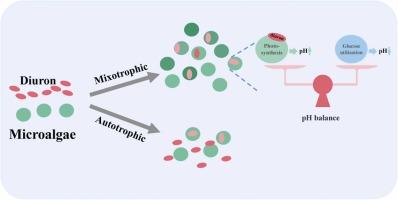From victims to protectors: microalgae's unexpected capacity for diuron elimination
IF 12.2
1区 环境科学与生态学
Q1 ENGINEERING, ENVIRONMENTAL
引用次数: 0
Abstract
Diuron is a widespread PSII-inhibiting herbicide that persists in aquatic ecosystems and threatens environmental health. However, cost-effective removal solutions remain elusive. This study revealed that microalgae have the ability to remove diuron efficiently under mixotrophic conditions, e.g., Parachlorella kessleri could completely remove 60 μg·L-1 of diuron within 60 hours. The primary process of this removal is bioabsorption, which relies more on new biomass generation than on total biomass. Additionally, diuron significantly enhances the mixotrophic growth of P. kessleri by maintaining a stable pH environment, stabilizing between 7.0 and 7.5 without the need for buffers or adjustments. This pH stabilization is attributed to diuron's reduction of the alkalizig effect of microalgal photosynthetic carbon assimilation. Other microalgae species, including Chlorella vulgaris, Chlorella ellipsoidea and Scenedesmus quadricauda, also show high diuron removal efficiencies and growth promotion under mixotrophic conditions. These findings collectively suggest that the use of mixotrophic microalgae could represent a new potential method for diuron removal.

求助全文
约1分钟内获得全文
求助全文
来源期刊

Journal of Hazardous Materials
工程技术-工程:环境
CiteScore
25.40
自引率
5.90%
发文量
3059
审稿时长
58 days
期刊介绍:
The Journal of Hazardous Materials serves as a global platform for promoting cutting-edge research in the field of Environmental Science and Engineering. Our publication features a wide range of articles, including full-length research papers, review articles, and perspectives, with the aim of enhancing our understanding of the dangers and risks associated with various materials concerning public health and the environment. It is important to note that the term "environmental contaminants" refers specifically to substances that pose hazardous effects through contamination, while excluding those that do not have such impacts on the environment or human health. Moreover, we emphasize the distinction between wastes and hazardous materials in order to provide further clarity on the scope of the journal. We have a keen interest in exploring specific compounds and microbial agents that have adverse effects on the environment.
 求助内容:
求助内容: 应助结果提醒方式:
应助结果提醒方式:


